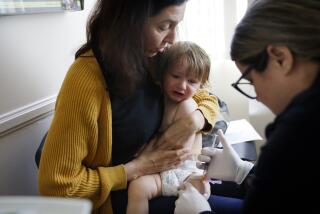1 in 45: New autism statistic suggests children with condition may have been undercounted
- Share via
As many as 1 in 45 American children may have autism spectrum disorder, according to a new government study that suggests the prevalence of the condition may have been undercounted for years.
Data from the 2014 National Health Interview Survey reveal that as many as 2.24% of U.S. children have received a diagnosis of autism spectrum disorder, or ASD, at some point in their lives, according to researchers from the Centers for Disease Control and Prevention.
That figure is markedly higher than the numbers published in other reports. For instance, surveys of children in 11 communities around the United States conducted by the CDC’s Autism and Developmental Disabilities Monitoring Network have found that 1 in 68, or 1.47%, of children have ASD. And the National Survey of Children’s Health found that 1.25% of U.S. children had ASD.
Autism spectrum disorder covers a range of conditions that impair communication and social skills and cause people to think, learn and behave differently than people with typically developing brains. Some people with ASD are high-functioning; others have trouble living independently. Autistic disorder, Asperger syndrome and pervasive developmental disorder not otherwise specified (PDD-NOS) are all considered part of ASD.
Awareness of the disorder has grown in recent years, as has a push for earlier diagnosis and intervention. But the striking increase in prevalence seen in the new report is mainly due to changes in the way the National Health Interview Survey was conducted, experts said.
Up through 2013, parents who completed the survey were asked whether a doctor or health professional had ever told them that their child had a developmental delay. Then they were asked to consider a list of 10 conditions and say whether their child had been diagnosed with any of them. Autism or ASD appeared sixth on the list, between sickle cell anemia and diabetes.
Starting in 2014, parents were asked about ASD first, then queried about other developmental delays. As a result, parents who in the past would have reported an intellectual disability or other neurocognitive disorder probably became more likely to report autism spectrum disorder, experts said.
Indeed, as the number of parents recalling an ASD diagnosis has grown, the prevalence of other conditions has dropped.
In particular, the proportion of parents who categorized their child as having some “other developmental delay” fell from 4.84% in 2011-2013 to 3.57% in 2014 -- a 26% decline. In addition, the proportion of parents who said a child had been diagnosed with an intellectual disability dipped from 1.27% in 2011-2013 to 1.1% in 2014 survey -- a 13% decline.
“The disease incidence isn’t changing,” Dr. David Agus, a professor of medicine and engineering at USC, said Friday on “CBS This Morning.” “Parents who said [their children] have a problem with an ‘other developmental delay’ are switching them to the ‘autism’ box.”
Compared with previous versions of the survey, the 2014 edition is probably “more sensitive in capturing the full population of children” with autism spectrum disorder, the study authors wrote.
At the same time, they cautioned that the new figures may overstate the number of children who currently have ASD. That’s because parents were asked whether their children had “ever” received a diagnosis, not whether they have the condition now.
“Maturation, misdiagnosis and effective treatment” might mean that a child once categorized as having ASD no longer meets the criteria for a diagnosis, they wrote.
Michael Rosanoff, an epidemiologist and director for public health research at Autism Speaks, said the results of a parent survey shouldn’t trump the CDC’s previous research on autism prevalence. However, he added that the 1-in-45 estimate was probably closer to the truth than the 1-in-68 figure.
“This means that 2% of children in the U.S. are living with autism,” Rosanoff said in a statement. “The earlier they have access to care, services and treatment, the more likely they are to progress.”
The new report was prepared by researchers from the National Center for Health Statistics and the National Center on Birth Defects and Developmental Disabilities, both parts of the CDC.
Follow me on Twitter @LATMelissaHealy and “like” Los Angeles Times Science & Health on Facebook.







